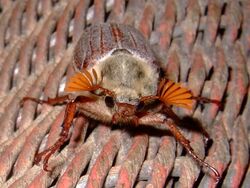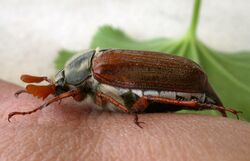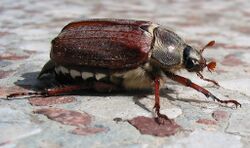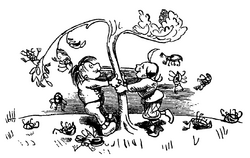Biology:Cockchafer
| Common cockchafer | |
|---|---|
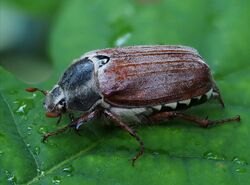
| |
| Female | |
| Scientific classification | |
| Domain: | Eukaryota |
| Kingdom: | Animalia |
| Phylum: | Arthropoda |
| Class: | Insecta |
| Order: | Coleoptera |
| Family: | Scarabaeidae |
| Genus: | Melolontha |
| Species: | M. melolontha
|
| Binomial name | |
| Melolontha melolontha Linnaeus, 1758
| |
The common cockchafer (Melolontha melolontha), colloquially called the Maybug,[1][lower-alpha 1] Maybeetle,[3] or doodlebug,[4] is a species of scarab beetle belonging to the genus Melolontha native to Europe. It is one of several closely related and morphologically similar species of Melolontha called cockchafers, alongside Melolontha hippocastani (the forest cockchafer). The adults and larvae feed on plants, and are regarded as serious agricultural pests of crops such as grasses and fruit trees.
Description
Adults of the common cockchafer reach sizes of 25–30 mm in length. The top of their bodies have hard, brown elytra with a black thorax and the underside is black and partly white on the sides. Larvae are white with an orange head.
Male cockchafers have seven "leaves" on their antennae, whereas the females have only six.[5]
Life cycle
Adults appear at the end of April or in May and live for about five to seven weeks. After about two weeks, the female begins laying eggs, which she buries about 10 to 20 cm deep in the earth. She may do this several times until she has laid between 60 and 80 eggs. The common cockchafer lays its eggs in fields. The preferred food for adults is oak leaves, but they will also feed on conifer needles.
The larvae, known as "white grubs" or "chafer grubs", hatch after four to six weeks. They feed on plant roots, for instance potato roots. The grubs develop in the earth for three to four years, in colder climates even five years, and grow continually to a size of about 4–5 cm, before they pupate in early autumn and develop into an adult cockchafer in six weeks.
The cockchafer overwinters in the earth at depths between 20 and 100 cm. They work their way to the surface only in spring.
Because of their long development time as larvae, cockchafers appear in a cycle of every three or four years; the years vary from region to region. There is a larger cycle of around 30 years superimposed, in which they occur (or rather, used to occur) in unusually high numbers (10,000s).
Pest control and history
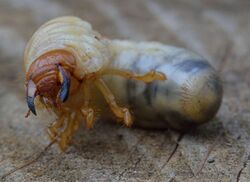
Middle ages
In the Middle Ages, pest control was rare, and people had no effective means to protect their harvest. This gave rise to events that seem bizarre from a modern perspective. In 1320, for instance, cockchafers were brought to court in Avignon and sentenced to withdraw within three days onto a specially designated area, otherwise they would be outlawed. Subsequently, since they failed to comply, they were collected and killed. (Similar animal trials also occurred for many other animals in the Middle Ages.)[6]
19th century
Both the grubs and adults have a voracious appetite and thus have been and sometimes continue to be a major problem in agriculture and forestry. In the pre-industrialized era, the main mechanism to control their numbers was to collect and kill the adult beetles, thereby interrupting the cycle. They were once very abundant: in 1911, more than 20 million individuals were collected in 18 km2 of forest.[1] Collecting adults was an only moderately successful method.
In some areas and times, cockchafers were served as food. A 19th-century recipe from France for cockchafer soup reads: "roast one pound of cockchafers without wings and legs in sizzling butter, then cook them in a chicken soup, add some veal liver and serve with chives on a toast". A Germany newspaper from Fulda from the 1920s tells of students eating sugar-coated cockchafers. Cockchafer larvae can also be fried or cooked over open flames, although they require some preparation by soaking in vinegar in order to purge them of soil in their digestive tracts.[7] A cockchafer stew is referred to in W. G. Sebald's novel The Emigrants.
In Sweden the peasants looked upon the grub of the cockchafer, Melolontha vulgaris, as furnishing an unfailing prognostic whether the ensuing winter will be mild or severe; if the animal has a bluish hue (a circumstance which arises from its being replete with food), they affirm it will be mild, but on the contrary if it is white, the weather will be severe: and they carry this so far as to foretell, that if the anterior be white and the posterior blue, the cold will be most severe at the beginning of the winter. Hence they call this grub Bemärkelse-mask—prognostic worm.[8]
Modern times
Only with the modernization of agriculture in the 20th century and the invention of chemical pesticides did it become possible to effectively combat the cockchafer. Combined with the transformation of many pastures into agricultural land, this has resulted in a decrease of the cockchafer to near-extinction in some areas in Europe in the 1970s.
Since the 1970s, agriculture has generally reduced its use of pesticides. Because of environmental and public health concerns (pesticides may enter the food chain and thus also the human body) many chemical pesticides have been phased out in the European Union and worldwide. In recent years, the cockchafer's numbers have been increasing again, causing damage to agricultural use of over 1,000 square kilometres (390 sq mi) of land all over Europe (0.001% of land).
At present[when?], no chemical pesticides are approved for use against cockchafers, and only biological measures are utilised for control: for instance, pathogenic fungi (such as Beauveria bassiana Spp. or Metarhizium[9]) or nematodes that kill the grubs are applied to the soil.
Name
The name "cockchafer"[10] derives from the late-17th-century usage of "cock"[11] (in the sense of expressing size or vigour) + "chafer"[12] which simply means an insect of this type, referring to its propensity for gnawing and damaging plants. The term "chafer" has its root in Old English ceafor or cefer, of Germanic origin and is related to the Dutch kever, all of which mean "gnawer" as it relates to the jaw. As such, the name "cockchafer" can be understood to mean "large plant-gnawing beetle" and is applicable to its history as a pest animal.
In culture
Children since antiquity have played with cockchafers. In ancient Greece, boys caught the insect, tied a linen thread to its feet and set it free, amusing themselves to watch it fly in spirals. English boys in Victorian times played a very similar game by sticking a pin through one of its wings.[13] Nikola Tesla recalls that as a child he made one of his first "inventions"—an "engine" made by harnessing four cockchafers in this fashion.[14]
Cockchafers appear in the fairy tales "Thumbelina" by Hans Christian Andersen and "Princess Rosette" by Madame d'Aulnoy.
The cockchafer is featured in a German children's song similar to the English Ladybird, Ladybird:
|
Maikäfer, flieg! |
Cockchafer, fly! |
The verse dates back to the Thirty Years' War in the first half of the 17th century, in which Pomerania was pillaged and suffered heavily. Since World War II, it is associated in Germany with the closing months of that war as well, when Soviet troops advanced into eastern Germany.
The dumbledore in Thomas Hardy's 1899 poem An August Midnight[15] is a cockchafer.[16]
There have been four Royal Navy ships named HMS Cockchafer.
See also
- Red-headed cockchafer, native to Australia
Explanatory notes
Citations
- ↑ 1.0 1.1 1.2 "Common Cockchafer". Bug Life. https://www.buglife.org.uk/bugs-and-habitats/common-cockchafer.
- ↑ Marren, Peter; Mabey, Richard (2010). Bugs Britannica. Chatto & Windus. ISBN 978-0-7011-8180-2. https://books.google.com/books?id=Ah62bUZLDOwC.
- ↑ "Cockchafer | insect" (in en). https://www.britannica.com/animal/cockchafer.
- ↑ "7 things you never knew about the cockchafer". Discover Wildlife. 8 April 2014. http://www.discoverwildlife.com/animals/7-things-you-never-knew-about-cockchafer.
- ↑ "Common cockchafer - Bug Directory" (in en-GB). https://www.buglife.org.uk/bugs/bug-directory/common-cockchafer/.
- ↑ Barton, K.: Verfluchte Kreaturen: Lichtenbergs "Proben seltsamen Aberglaubens" und die Logik der Hexen- und Insektenverfolgung im "Malleus Maleficarum", in Joost, U.; Neumann, A. (eds): Lichtenberg-Jahrbuch 2004, p. 11ff, Saarbrücken 2004 (SDV Saarländische Druckerei und Verlag), ISBN:3-930843-87-0. In German.
- ↑ Cooking cockchafer with old-timey Europeans 11 February 2016 www.bugsfeed.com accessed 30 May 2021
- ↑ De Geer, iv. 275–6. Kirb. and Sp. Introd., i. 33.
- ↑ Agroscope. "Grub control using entomopathogenic fungi" (in en). https://www.agroscope.admin.ch/agroscope/en/home/themen/pflanzenbau/pflanzenschutz/biologische-schaedlingsbekaempfung/entomopathogene_pilze.html.
- ↑ cockchafer (n.) www.etymonline.com accessed 30 May 2021
- ↑ cock (n.1) www.etymonline.com accessed 30 May 2021
- ↑ chafer (n.) www.etymonline.com accessed 30 May 2021
- ↑ Martin, William (1866). "Peter Parley's annual: A Christmas and New Year's present for young people". https://books.google.com/books?id=zSIGAAAAQAAJ.
- ↑ Tesla, Nikola (1919). "My Inventions". Electrical Experimenter. https://en.wikisource.org/wiki/My_Inventions.--
- ↑ Collected poems of Thomas Hardy, 1923, p154
- ↑ Brown, Joanna Cullen, Review of Thomas Hardy: Cent Poèmes. Anthologie bilingue (Les Editions de L’Aire, Vevey, 2008) by Eric Christen, Françoise Baud, The Hardy Society Journal, Vol. 4, No. 3 (Autumn 2008), pp. 87
External links
| Wikimedia Commons has media related to Melolontha melolontha. |
- Der Maikäfer , from the Senckenberg Museum in Frankfurt (in German)
Wikidata ☰ Q28175 entry
 |
